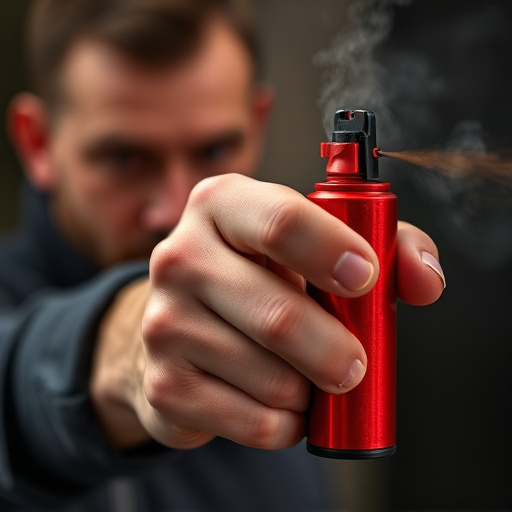Pepper spray, a common self-defense tool, uses capsaicin (a chili pepper compound) to temporarily disable attackers. Activation releases a mist of capsaicin molecules that bind to nerve endings, causing pain and inflammation for 20-60 minutes. Symptoms include temporary blindness, breathing difficulties, and severe pain. Effects can persist up to an hour or longer, with prolonged exposure leading to health complications. Environmental factors like temperature, humidity, and sunlight impact spray potency. Aftereffects peak within minutes, including tearing, itching, difficulty breathing, and nausea; recovery varies based on exposure duration and sensitivity. Staying hydrated, keeping affected areas clean, and seeking medical advice for severe symptoms are essential.
“Discover the power of pepper spray as a deterrent and understand its impact on self-defense. This comprehensive guide explores the active ingredients that make it an effective tool, revealing how long its effects can last. We delve into the factors influencing its lifespan, including environmental conditions, providing insights into the duration of protection.
Furthermore, learn about the aftereffects and recovery time associated with pepper spray exposure, offering a clear picture of what to expect in the aftermath of its use. Get ready to unravel the science behind this popular defense mechanism.”
- Understanding Pepper Spray: Active Ingredients and Their Effects
- Duration of Pepper Spray Exposure: How Long Does It Last?
- Factors Influencing Pepper Spray's Lifespan: Environmental Conditions
- Aftereffects and Recovery Time: What to Expect Following Exposure
Understanding Pepper Spray: Active Ingredients and Their Effects
Pepper spray, a popular self-defense mechanism, is a chemical compound designed to temporarily incapacitate an attacker. Its primary active ingredient is capsaicin, a compound found in chili peppers that stimulates nerve endings and causes a burning sensation. When deployed, pepper spray creates a mist that contains tiny particles, each carrying millions of capsaicin molecules. These molecules bind to receptors in the eyes, nose, throat, and skin, leading to inflammation and pain.
The effects of pepper spray can last for several minutes, typically ranging from 20 to 60 minutes, depending on the concentration and amount used. During this period, individuals exposed may experience teary eyes, difficulty breathing, coughing, and extreme discomfort. This temporary incapacitation allows users to escape potentially dangerous situations. Understanding how long pepper spray effects last is crucial for its effective use as a deterrent, ensuring individuals have sufficient time to get away and seek help if needed.
Duration of Pepper Spray Exposure: How Long Does It Last?
The duration of pepper spray exposure and its effects on the human body is a critical factor in understanding its effectiveness as a deterrent. The active ingredient in pepper spray, capsaicin, causes a range of symptoms, including temporary blindness, difficulty breathing, and severe pain. These symptoms typically peak within 15 to 30 seconds after exposure and can last for several minutes. However, the intensity of the effects varies based on the concentration of capsaicin, the method of application, and individual sensitivity.
While the immediate impact might subside after a few minutes, the residual effects can persist for up to an hour or longer. This means that even after the initial sensory overload, victims may still experience reduced visibility, coughing, and difficulty in physical activity. It’s important to note that prolonged exposure or repeated doses could lead to more severe health complications, underlining the need for proper training and responsible use of pepper spray as a defense mechanism.
Factors Influencing Pepper Spray's Lifespan: Environmental Conditions
Pepper spray, a popular self-defense mechanism, is effective due to its active ingredient capsaicin, which disrupts an attacker’s vision and breathing. However, several environmental factors influence how long pepper spray remains potent and effective. Temperature plays a significant role; extreme heat can degrade the spray, while cold temperatures may solidify it, affecting application. Humidity levels are another critical factor; high humidity can reduce the spray’s effectiveness by causing capsaicin to dissolve faster in water droplets present in the air. Sunlight exposure is also detrimental, as UV rays can break down the chemical composition of pepper spray over time. These environmental conditions must be considered when choosing and storing pepper spray for optimal self-defense preparation.
Aftereffects and Recovery Time: What to Expect Following Exposure
After exposure to pepper spray, individuals can expect a range of aftereffects, which typically peak within minutes and may last for several hours. The primary active ingredient in pepper spray is capsaicin, which irritates the eyes, nose, throat, and skin, leading to tearing, itching, burning sensations, and difficulty breathing. In some cases, people might experience nausea, dizziness, or even temporary blindness. Recovery time varies based on factors like the amount of spray used, duration of exposure, and individual sensitivity.
Generally, symptoms start to subside after a few hours as the body’s natural cooling mechanisms kick in. Eye irritation and tearing may last up to 48 hours, while breathing difficulties can persist for several hours. It’s crucial to stay hydrated, keep affected areas clean, and seek medical attention if symptoms are severe or persistent. Those with pre-existing conditions like asthma or heart disease should be especially mindful of their recovery process, as pepper spray could potentially exacerbate these issues.
Pepper spray, while a powerful deterrent, is not indomitable. Understanding its active ingredients, duration of effects, and the factors influencing its lifespan is crucial for effective self-defense. Knowing that symptoms can last from 20 minutes to an hour, and environmental conditions like temperature and humidity can extend or shorten this time, individuals can make informed decisions in potentially dangerous situations. Moreover, being aware of the aftereffects and recovery time allows for proper preparation and care following exposure, ensuring safety and peace of mind.
